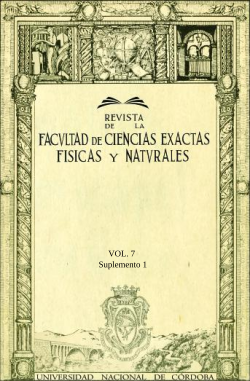Bailey Willis: Un geólogo yanqui y el desarrollo del norte de la Patagonia
Keywords:
Bailey Willis, Applied Geology, Patagonia.Abstract
Bailey Willis was born in 1857 in New York City and died in Palo Alto, California in 1949. He earned degrees as Mining Engineer and Civil Engineer from Columbia University. He worked as a geologist and taught geology at Johns Hopkins, Chicago and Stanford Universities. He specialized in structural geology and seismology. He was a member of the National Academy of Sciences and President of the Geological and Seismological Societies of his country. Between 1910 and 1914 he was in Argentina where he headed a Commission for Hydrological Studies that carried out the first detailed mapping of the south of the Province of Rio Negro, aimed at providing drinking water to San Antonio Oeste and to build a railroad line to Lake Nahuel Huapi and Chile. In 1913 Bailey Willy drafted a proposal setting out a series of conditions to colonize the "Province of Cordillerana", between the 38° and 44°S, which he considered suitable to sustain 3,000,000 inhabitants. The studies also included an assessment of the possible links of the San Antonio railroad. The results of these studies were included in a book, entitled "El Norte de la Patagonia", of which the first of the two intended volumes was published in 1914, where it was proposed, the creation of a city and industrial pole immediately east of Lake Nahuel Huapi, as well as a National Park between Junín de los Andes and Esquel. The detailed originals of both projects were published a century later. His experiences in the four years he spent in Argentina were recounted in his book "A Yanquee in Patagonia", published in 1947. The work developed in northern Patagonia by Bailey Willis and his 10 collaborators over a span of less than three years can be considered exceptional. From a geological point of view it was mainly applied, from hydrogeology and hydrology, to the construction of dams and bridges, the layout of roads and railways, soil studies and urban planning.
Downloads
References
[1] Blackwelder E. (1961), “Bailey Willis, 1857-1949. Biographical Memoir”. National Academy of Sciences, Washington D.C., pp. 333-350.
[2] Bustillo E. (1999), El Despertar de Bariloche, Editorial Sudamericana, primera edición, 1968, quinta edición 1999, p. 1-526.
[3] Quensel P. D. (1912), “On the influence of the Ice Age on the continental watershed of Patagonia”, Bulletin of the Geological Institute of Uppsala, 9: 252-290.
[4] Willis B. (1912a), “Forty-first parallel survey of Argentina”. Comptes Rendus XII Congrès Géologique Internationale, pp. 713-731.
[5] Willis B. (1912b), “Phisiography of the Cordillera de los Andes”. Comptes Rendus XII Congrès Géologique Internationale, 733-756.
[6] Willis B. (1914), El Norte de la Patagonia: Naturaleza y Riquezas. Scribner Press, New York. vol. 1, pp. vii-xix, 1-500; vol. 2, 11 Mapas.
[7] Willis B. (1914b), The Physical Basis of the Argentine Nation. Journal of Race Development, 4: 443-460.
[8] Willis B. (1916), “The awakening of Argentina and Chile”, National Geographic Magazine, 30(2): 121-142.
[9] Willis B. (1943), Historia de la Comisión de Estudios Hidrológicos del Ministerio de Obras Públicas – 1911 – 1914. Ministerio de Agricultura, Dirección de Parques Nacionales y Turismo. Buenos Aires, pp. 1-170.
[10] Willis B. (1949), Friendly China: Two thousand Miles afoot among the Chinese. Stanford University Press, I-xviii, 312 p.
[11] Willis B. (2001), Un Yanqui en Patagonia. Editorial Sudamericana, Buenos Aires, pp. 1-189. Traducción al castellano de “A Yanqui in Patagonia”. Stanford University Press, 1947.
[12] Willis B. (2017), El norte de la Patagonia II: estrategias y proyectos. Libro Digital, pdf 558 p. + CD-DVD. Editado por De Jong, G.M., Messera, E.M. y Mare, M.D. Neuquén: EDUCO – Universidad Nacional del Comahue.
Downloads
Published
Issue
Section
License
Copyright (c) 2020 Facultad de Ciencias Exactas, Físicas y Naturales (Universidad Nacional de Córdoba)

This work is licensed under a Creative Commons Attribution 4.0 International License.
Los autores que publican en esta revista están de acuerdo con los siguientes términos:
Los autores conservan los derechos de autor y conceden a la revista el derecho de la primera publicación.
Los autores pueden establecer por separado acuerdos adicionales para la distribución no exclusiva de la versión de la obra publicada en la revista (por ejemplo, situarlo en un repositorio institucional o publicarlo en un libro), con un reconocimiento de su publicación inicial en esta revista.
Se permite y se anima a los autores a difundir sus trabajos electrónicamente (por ejemplo, en repositorios institucionales o en su propio sitio web) antes y durante el proceso de envío, ya que puede dar lugar a intercambios productivos, así como a una citación más temprana y mayor de los trabajos publicados (Véase The Effect of Open Access) (en inglés).



